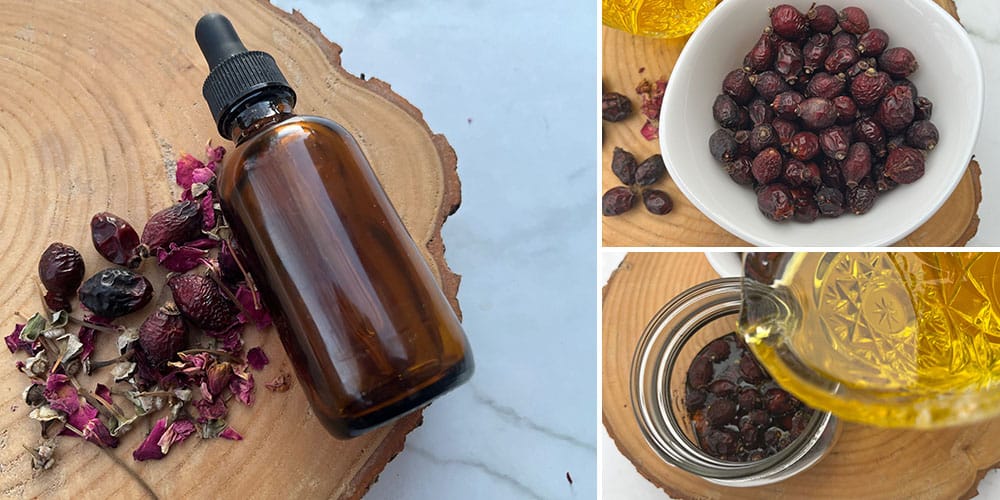
Better Than Retinol
In the race to achieve younger, healthier skin, retinol is the frontrunner in the cosmetic and skincare industry.
However, many people have reservations about this potent synthetic ingredient, which has many side effects and isn’t suitable for all skin types. Let’s look at the natural alternatives that are better than retinol and how you can make them yourself at home.
What Does Retinol Do to Your Skin?
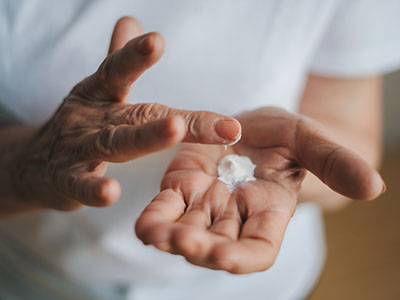
Retinol is a popular skincare ingredient derived from Vitamin A. It is commonly used for its anti-aging properties and its ability to help treat skin conditions such as acne. Retinol most notably increases collagen formation in the skin, which helps reduce fine lines and wrinkles. The result is a plump and more youthful appearance.
The Vitamin A in Retinol helps with cellular growth and repair, which is beneficial if you tend to have fine lines and wrinkles due to sun damage to your skin. Retinol also helps to unclog your pores and works as an exfoliant in the skin, which makes it useful for treating and managing acne-prone skin and reducing inflammation.
What Are the Side Effects of Retinol?
Though less potent than other retinoids, retinol isn’t ideal if you are prone to allergies or have very sensitive skin. In addition, retinol causes photosensitivity.
This means that it makes your skin very sensitive to UV rays and can make you more susceptible to sunburn if you don’t use it with sunscreen or avoid the sun. Common side effects of retinol also include: dryness, itchiness, irritation or a burning sensation, dry, flaky skin, peeling skin and discomfort.
How to Make Natural Retinol at Home
In addition to the potential side effects, many people dislike retinol because it is a synthetic product. People are becoming more aware of the ingredients in their skincare routine and want products to help simplify their skincare routine while effectively nourishing their natural skin type and concerns. Here are a few of nature’s retinol alternatives!
Bakuchiol
Bakuchiol, made from Babchi seed oil, has recently become a popular Retinol alternative. The seeds from the Babchi plant (Psoralea corylifolia), grown in Asia, have a long history of use in Chinese and Indian medicine, particularly when treating skin conditions. The finished product, Bakuchiol, is a potent antioxidant that helps stimulate collagen production. Bakuchiol has been marketed as the next up-and-coming alternative to retinol and has even made its way into the formulations of popular skincare brands. Babchi seeds are very hard to find in North America but may become more available if the demand remains high.
Rosehip Oil
Rosehip oil is another natural Retinol alternative that is easier to source. You can even make it yourself. Unlike rose oil, which uses an extract from rose petals themselves, rosehip oil is infused from the seeds or fruit of the rose plant.
Why Rosehip Oil?
Rosehip oil is very nourishing and hydrating to the skin and will also help solve the two primary functions of retinol without using synthetics. It’s high in Vitamin A, which encourages cellular growth and repair and promotes collagen in the skin. It can also help reduce the appearance of scarring and reduce discoloration in the skin.
Rosehip oil is naturally high in essential fatty acids, including Omega-3 fatty acids, which help to create a healthy barrier on the skin while keeping it hydrated. At the same time, Rosehip oil prevents the skin from feeling greasy and causing clogged pores. It’s naturally moisturizing and hydrating for the skin and can even help regulate your natural oil production, reducing breakouts.
Rosehip oil is also much gentler than retinol, making it more compatible for those with sensitive skin. It can help reduce irritation caused by conditions like eczema or psoriasis.
Nicole’s Apothecary also has a ready-made All-Purpose Salve, which you can use for everything from cuts and stings, to eczema and rashes.
DIY Rosehip Infused Oil
While manufacturers press rosehips or rosehip seeds to formulate rosehip oil, you can create your own rosehip oil infusion at home.
Rosehips
Occasionally referred to as the rose fruit, rosehips are the bulbs found underneath the beautiful rose petals. These bulbs contain the rose seed. They can be found in the late summer or fall when the petals have dropped from the rose plant and harvested. For your at-home rosehip-infused oil, you can use fresh rose hips or dried ones. Since rose hips are commonly used for tea, you can find both whole rose hips or ones that have been sliced thinly.
Carrier Oils
Typically, cold pressed rosehip oil is a carrier oil in itself, but since we are making a rosehip oil infusion at home, you will want to choose a carrier oil, depending on which one you are most comfortable with for your skin type. You can also experiment with using different types of carrier oils or mixing oils to find one that works best for you. Here are a few we recommend for your retinol substitute:
Jojoba oil: Jojoba oil is commonly used for skincare since it is gentle enough for sensitive skin and hypoallergenic. It is highly moisturizing, but does not clog pores and will not leave an oily residue on the skin. Not only that, but it also helps with collagen production and will provide additional anti-aging benefits.
Avocado oil: Avocado oil is another nourishing, anti-inflammatory that can help heal dry, flaky skin associated with psoriasis and eczema. It can also help reduce both inflammation and redness caused by acne. Avocado oil is another great option for acne-prone skin as it does not leave an oily residue.
Sweet almond oil: Sweet almond oil is rich in Vitamin A, Vitamin E, Omega-3 Fatty Acids, and Zinc, making it another gentle anti-inflammatory for your skin. It’s very helpful for healing skin conditions, thanks to the Vitamin E, and helps improve cell turnover. This makes it ideal for acne-prone skin or those who suffer from eczema or psoriasis. It also will not leave your skin feeling oily, but it is still highly moisturizing.
Ingredients:
- 1 cup of carrier oil (for example, Jojoba oil or sweet almond oil)
- ½ cup of dried rosehips (or ¾ cup fresh)
- Two glass jars
- An amber bottle, such as a dropper bottle
- Cheesecloth or a strainer
Steps:
- First, pour your rose hips and your carrier oil into a glass jar.

- Stir the jar to ensure the rose hips are fully covered.
Slow-Infusion (Cold Infusion)
Leave your sealed jar in a cool, dark, dry place for 1-2 weeks to infuse slowly.
Heat Method:
- Fill a pot with enough water to submerge approximately half of your jar.
- Place your jar in the middle of the pot. Do not seal the jar with the lid.
 Simmer on low heat for 2-4 hours. You will want to check on your pot regularly and add warm water as needed if it evaporates.
Simmer on low heat for 2-4 hours. You will want to check on your pot regularly and add warm water as needed if it evaporates.- Remove from heat and allow the jar to sit in the warm bath until the water and infused oil have cooled (typically, this can take several more hours)
Straining
- When your oil has fully cooled after heat-infusing (or has been cold-infused for 1-2 weeks), you can begin straining your oil.
- Ready your second glass jar.
- Place a cheesecloth or strainer over the clean jar and pour your infusion through the strainer.
 How to Use and Store Rosehip Oil
How to Use and Store Rosehip Oil
To store your homemade rosehip infusion, keep the oil in an amber bottle to protect it from light. Store it in a cool, dry location. In the summer, you can even keep your rosehip oil in the refrigerator.
If you use dried rosehips, your oil infusion is as good as the expiration date on the carrier oil used, so be mindful of that. 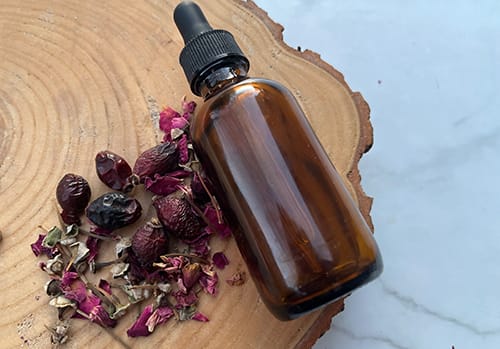
If this is your first time trying rosehip oil or your first time using any of the carrier oils, it’s best to do a spot test on your skin before use.
In addition to your daily skincare, you can add a few drops of rosehip oil to your bath to nourish your skin. It will also have a floral, relaxing aroma. You can also add a few drops of rosehip oil to your moisturizer as needed.
Other Ingredients You Can Add to Your Rosehip Oil
For additional skin care benefits, there are a few other ingredients you can add to your Rosehip infusion, such as:
Wild Rose petals: They work very well in combination with rosehips in a remedy, due to their anti-ageing properties.
Rosemary extract: You can infuse rosemary or rosemary extract to your rosehip oil if you are looking for a potent antioxidant that is particularly beneficial for acne-prone skin. Like the calendula oil, it always helps to do a small allergy spot test of rosemary on your skin before use.
Chickweed: It soothes inflammation and it’s cooling for hot, red skin.
Turkey Tail mushrooms: You can infuse the mushrooms in a carrier oil for a nourishing and antioxidant infused oil.
Chamomile: If you want a true rescue remedy for irritated skin, consider adding chamomile to your infusion.
Lavender: It’s antimicrobial and good for reducing irritation and redness.
Calendula: It is beneficial for treating conditions like eczema or reducing redness and irritation.
These are really heal-all plants when it comes to any type of skin issue. To soothe my skin condition, I bought these seeds to grow my own medicinal plants at home. Now I have an endless supply on hand and I make herbal remedies often.








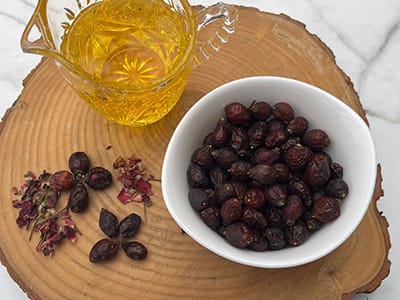

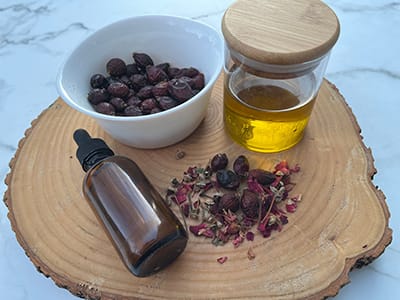
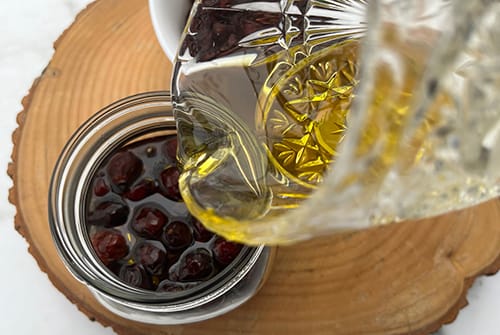
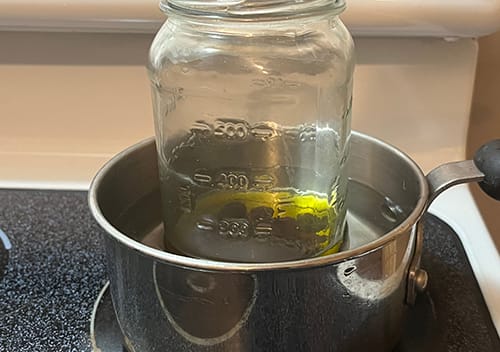 Simmer on low heat for 2-4 hours. You will want to check on your pot regularly and add warm water as needed if it evaporates.
Simmer on low heat for 2-4 hours. You will want to check on your pot regularly and add warm water as needed if it evaporates.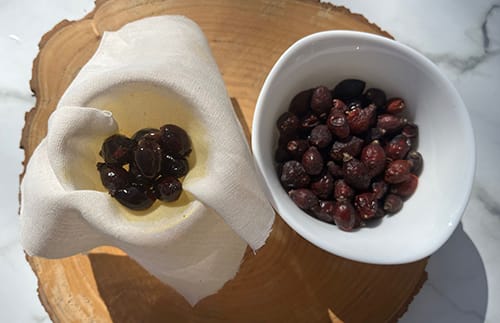 How to Use and Store Rosehip Oil
How to Use and Store Rosehip Oil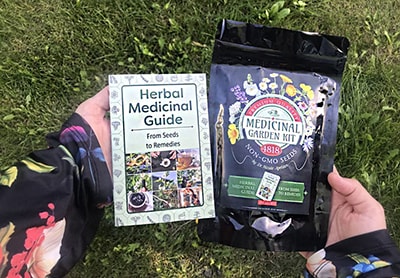
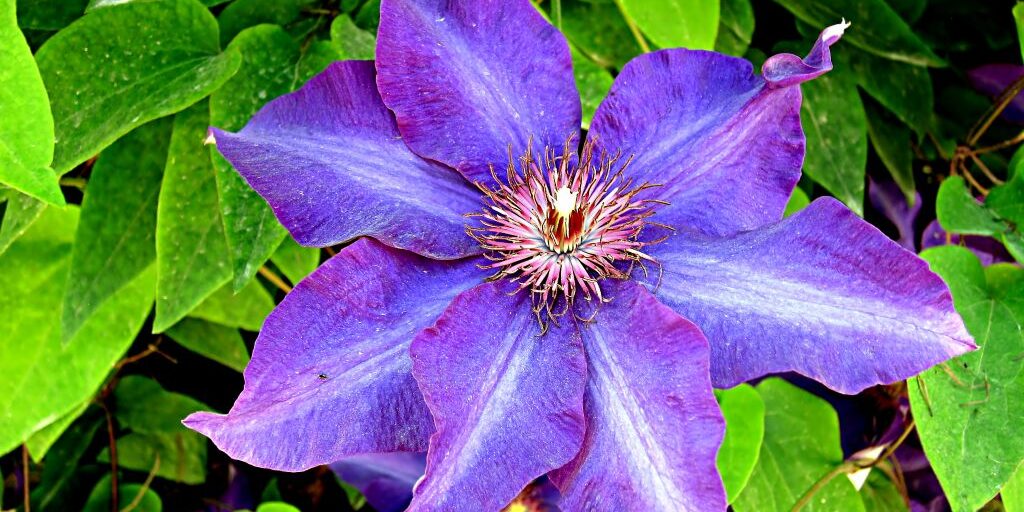
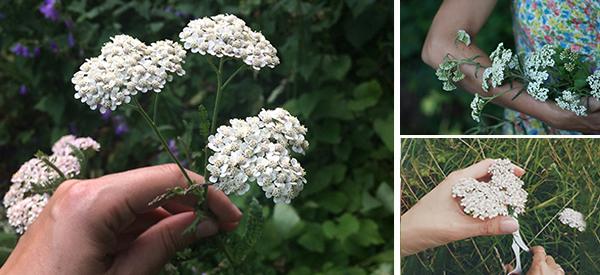

Do i use this daily? U just ordered all my ingredients to make it
Hi Jannie,
Yes, you can use it daily, but make sure to do a patch test first.
Many blessings and good health!
Can you use Argan Oil as the carrier? Thanks!
Hi Phil,
Yes, Argan Oil is a great choice for carrier oil.
Many blessings and good health!
Doesn’t oil make acne worse? You clogg the pores with it.
Does this help with tightening crepey skin?
Will this be as effective, nourishing and as potent as actual rosehip oil, like the same benefits and equal to, or not quite as strong?
Also if I was to obtain babchi seeds, would it be the same process to make a babchi seed infusion? Will this to have similar benefits?
Thank you 🙏
Can you also use fresh rosehips or should they be dried first?